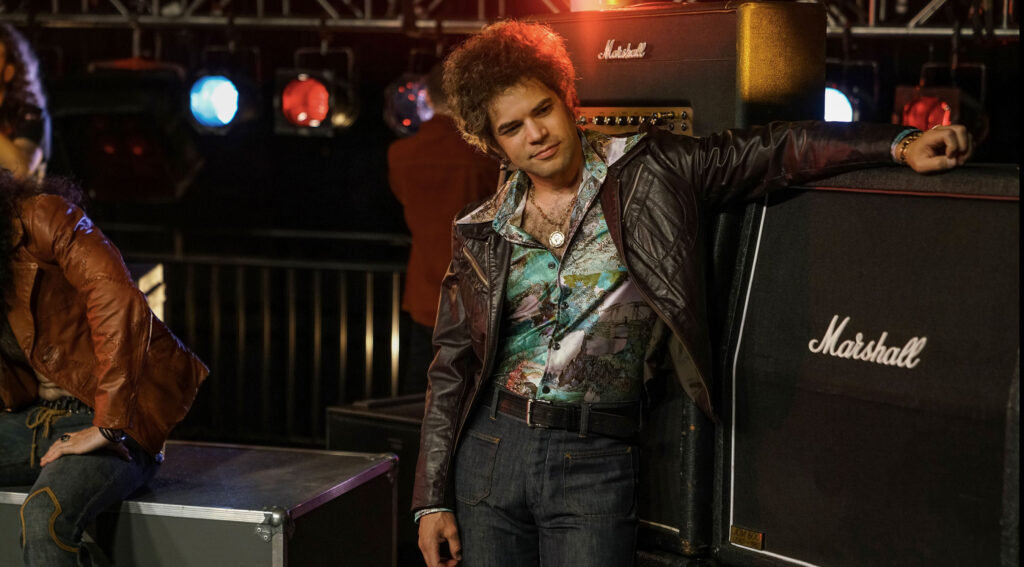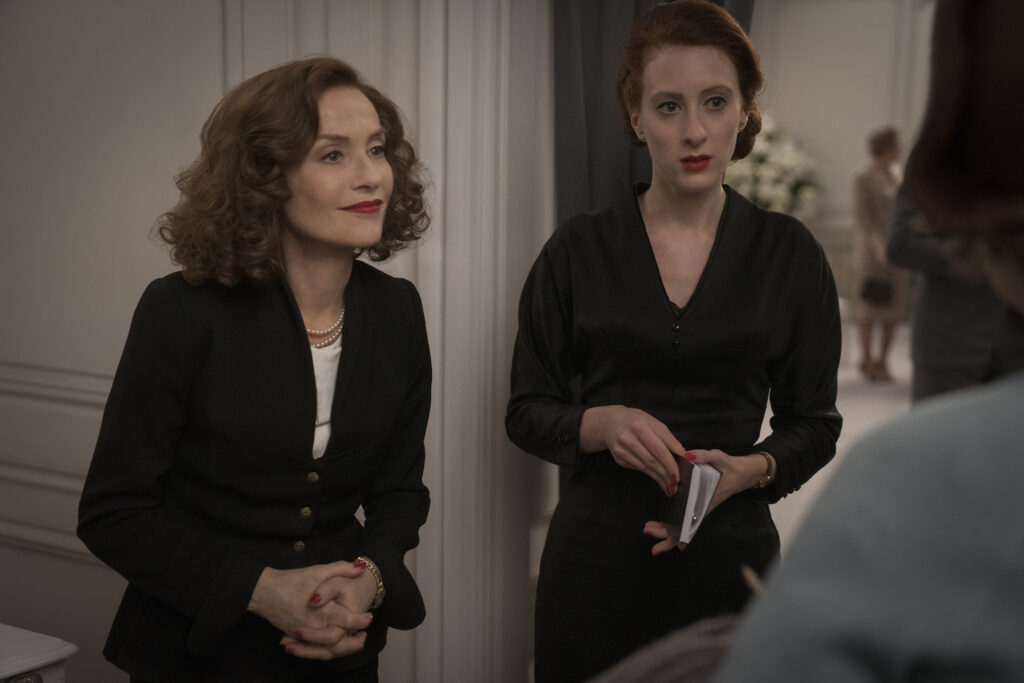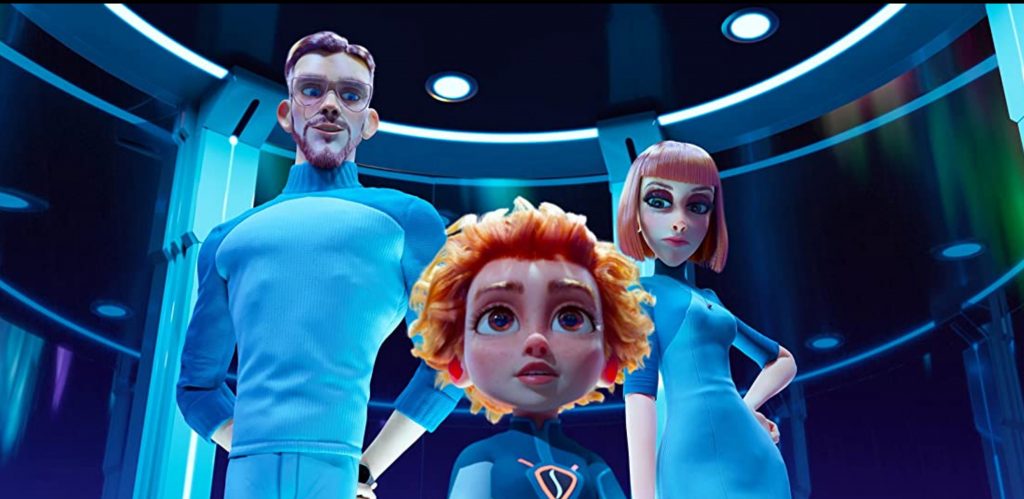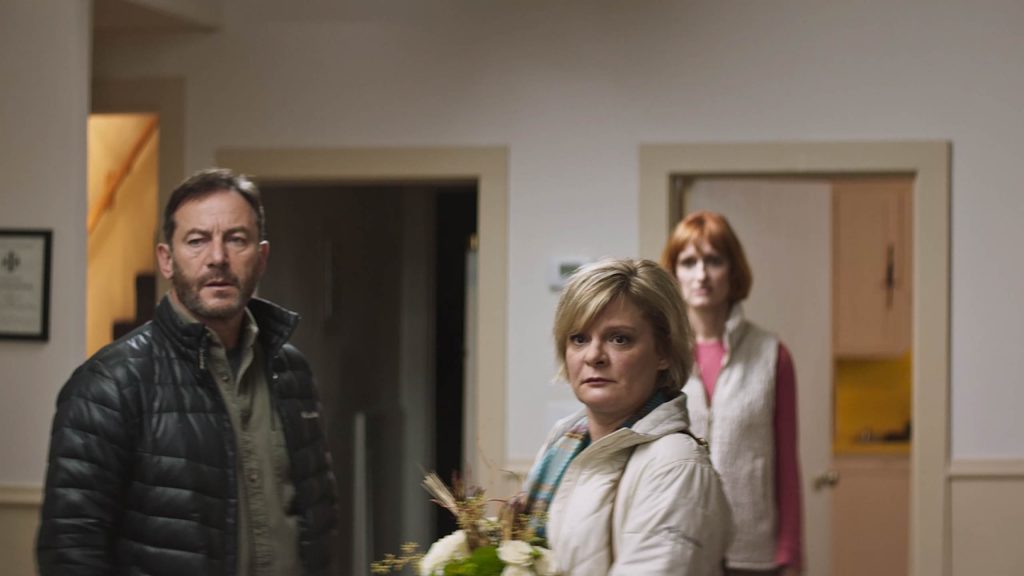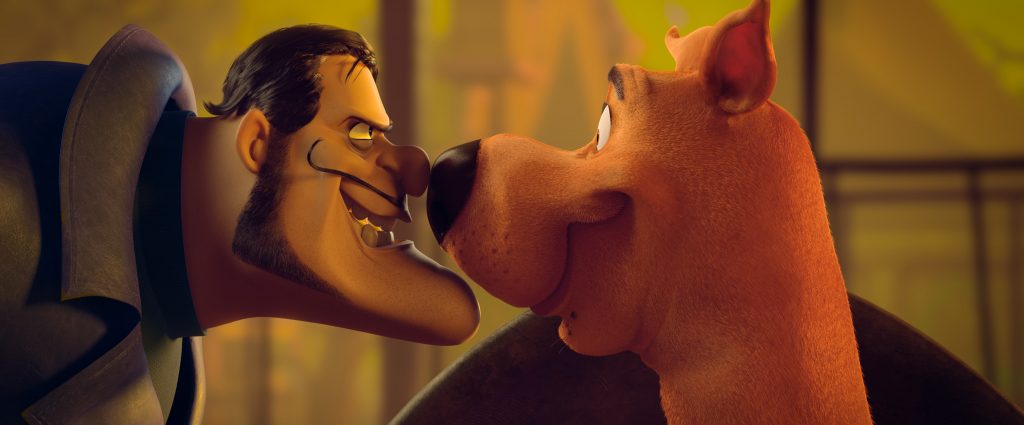July 30, 2023
by Carla Hay

“Have You Got It Yet? The Story of Syd Barrett and Pink Floyd”
Directed by Roddy Bogawa and Storm Thorgerson
Culture Representation: The documentary film “Have You Got It Yet? The Story of Syd Barrett and Pink Floyd” features a nearly all-white group of people (with one Latino) discussing the life of Pink Floyd co-founder Syd Barrett, who died of pancreatic cancer in 2006, when he was 60 years old.
Culture Clash: Barrett, who was in Pink Floyd from 1965 to 1968, rocketed to fame when the band’s first two singles and first album were hits, but his drug abuse, mental breakdowns and increasing unreliability led to him being fired from the band, and he became a recluse from the mid-1970s until his death.
Culture Audience: Besides appealing to the obvious target audience of Pink Floyd fans and rock music fans, “Have You Got It Yet?” will appeal to people interested in true stories about the psychedelic 1960s and the highs and lows of fame.

“Have You Got It Yet? The Story of Syd Barrett and Pink Floyd” is a fitting biography of Syd Barrett (co-founder of the British rock band Pink Floyd), with an impressive array of exclusive interviews with his associates. Some viewers might be surprised that many people interviewed for this documentary (including co-director Storm Thorgerson) died years ago. There have been several books and articles written about Barrett (who died of pancreatic cancer in 2006, when he was 60 years old), as well as a few unauthorized documentaries about him.
However, “Have You Got It Yet?” (which has narration by actor Jason Isaacs) is by far the most comprehensive documentary about Barrett’s life because of the numerous people who were close to him who are interviewed for this film. The documentary also has a few of Barrett’s famous musician fans weigh in with their thoughts. There’s also commentary from some psychiatrists (because Barrett had serious mental health issues) and a few writers.
Directed by Thorgerson (who died in 2013) and Roddy Bogawa (one of the producers of this documentary), much of “Have You Got It Yet?” was obviously filmed several years before this documentary was completed and released. Thorgerson, who knew Barrett since the early 1960s, was a longtime colleague of Pink Floyd’s because Thorgerson was a co-founder of the art design group Hipgnosis, which designed almost all of Pink Floyd’s album covers since 1968. In “Have You Got It Yet?,” Thorgerson’s voice is heard asking and reacting to many of the questions asked of the people interviewed. He also appears on camera to do his own interview commentary.
A lot of facts about Barrett are already known to many people who are knowledgeable about rock music. Born in 1946, in Cambridge, England, his birth name was Roger Keith Barrett. He got the nickname Syd as a child, although his family still called him Roger or Rog. Barrett was the third of five siblings who grew up in a middle-class home with married parents. His pathologist/botanist father Arthur Max Barrett encouraged Syd’s artistic inclinations.
Syd became an avid painter of abstract art and a musician, with the guitar as his main instrument of choice. Several people in the documentary describe Syd as highly intelligent, constantly curious, and very talented, before he became a recluse and many people he knew were no longer in contact with him. Johnny Gordon, a childhood friend from Syd’s art school days, remembers that Syd “had a flair way beyond his years.”
Syd’s father Arthur died of cancer in 1961, when Syd was 15 years old. There’s nothing in the documentary that talks about how Syd was emotionally affected by his father’s death. It’s mentioned that the family moved to a new house in Cambridge after Arthur died. Moving to this new neighborhood led to Syd meeting his first serious girlfriend: Libby Gausden, who lived near the Barrett family and met Syd at a local public swimming pool.
Gausden, who is interviewed in the documentary, says that she and Syd dated from 1961 to 1964. She remembers, “He was kind, he was gentle, he was generous. He liked buying presents. He wrote to me all the time.” Syd attended Cambridgeshire College of Arts and Technology, where he met future Pink Floyd member David Gilmour, who also knew Gausden. She says that Gilmour was with her at the swimming pool on the day that she met Syd.
Gilmour remembers how Syd was at the time: “He walked with a bounce.” The romance between Syd and Gausden fell apart in 1964, after Syd moved to London to go Camberwell College of Arts. During his time at Camberwell College of Arts, Syd’s next serious girlfriend was Jenny Spires, who says in a documentary interview that she and Syd began dating about a week after they met. She describes him as fun and romantic, but she broke up with him for reasons that she doesn’t give details about in the movie. Spires vaguely says that she just wanted to move on from the relationship.
Out of all of his siblings, Syd was closest to his younger sister Rosemary Breen, who became his caretaker during Syd’s reclusive years. Breen remembers Syd this way before he had his drug-induced mental breakdowns: “He was always wanting the next bit of fun.” She also says that she only saw Syd perform once with Pink Floyd, sometime in the late 1960s. Breen remembers that Syd didn’t look like he was having any fun, and she wasn’t interested in seeing him perform on stage again after that experience.
Breen being in this documentary is crucial to why “Have You Got It Yet?” stands out from other accounts of Syd’s life. She is the only person interviewed in the documentary who knew what Syd was really like during all the years when he chose to disappear from the public eye. The pain of what she went through is etched all over her face when she talks about Syd’s reclusive years (she says he was incapable of having a job), but she also shares her fond memories of what Syd was like before fame and drugs destroyed a lot of the vibrancy that he had in his youth.
Like many British rock stars who found fame in the 1960s, Syd went to art school, which was a viable option for teenagers who couldn’t see themselves working in traditional or conventional jobs. When Syd moved to London in 1964, he ended up living in the same apartment as the musicians who would be in the original lineup of Pink Floyd: vocalist/bass guitarist Roger Waters, keyboardist Richard “Rick” Wright and drummer Nick Mason. (Pink Floyd, which was formed in 1965, was originally called the Pink Floyd Sound, and later the Pink Floyd.) They were influenced by blues music, the Rolling Stones and the Beatles.
Syd sang lead vocals, played lead guitar, and wrote most of Pink Floyd’s songs at the time. He also came up with the band’s name, which was a combination of the first names of two blues musicians he admired: Pink Anderson and Floyd Council. By all accounts, Syd was Pink Floyd’s original mastermind.
In the documentary, Waters says of Pink Floyd’s success: “It wouldn’t have existed if it hadn’t been for Syd. We would’ve been one of thousands and thousands of bands who come up … and then disappear.” In the first few years of Pink Floyd, the band quickly went to the forefront of the emerging psychedelic rock scene, where LSD (nicknamed acid) was consumed as often as many people drank coffee or drank alcohol.
Although Pink Floyd’s music and image changed after Barrett was ousted from the band in 1968, Pink Floyd was considered one of the pioneers of psychedelic rock. The characteristics of psychedelic rock included long jam sessions for each song, experimental noises, and hypnotic and dazzling light shows. At the time, it wasn’t just different to perform rock music this way. It was revolutionary. Syd began making enough money as a working musician in Pink Floyd, so he eventually quit art school and never went back.
The documentary “Have You Got It Yet?” gets its title from a notorious song of the same name that Syd wrote where he deliberately kept changing the song. The ironic joke was that the answer would be “no” if anyone asked in reference to fully knowing the song: “Have you got it yet?” In the documentary, Nick Laird-Clowes (of Dream Academy fame) describes Syd’s songwriting this way: “He has a strange bridge of Edwardian musical vaudeville and his own particular brand of psychedelia.”
After signing with EMI Records, success came quickly for Pink Floyd, whose first two singles, released in 1967—”Arnold Layne” and “See Emily Play”—hit No. 20 and No. 6, respectively, on the United Kingdom’s singles charts. The band’s 1967 debut album, “The Piper at the Gates of Dawn,” was a Top 10 hit in the United Kingdom. By all accounts, Syd was uncomfortable with fame, and his drug use escalated. He began to disappear when the band needed to work.
Peter Jenner, who was Syd’s former manager, says in the documentary: “There was religious acid-taking at that time. Syd was one of the saints of that underground cult.” Unfortunately for Syd, he became a “poster boy” for excessive drug use, which led to his personal downfall. In addition to Syd having drug-induced mental breakdowns, it became more difficult for him to function and communicate. If he showed up somewhere, it wasn’t unusual for him not to know where he was or not recognize people he knew.
Gilmour remembers visiting Pink Floyd in 1967 and being dismayed at the deterioration of Syd: “He had lost his bounce and spark. And that was really an odd and uncomfortable moment.” In 1968, guitarist/vocalist Gilmour joined Pink Floyd as a fifth member, around the time that Syd started to become increasingly unreliable and estranged from the rest of the band. Syd was eventually fired a few months after Gilmour became an official Pink Floyd member. In the documentary, Mason says the obvious about Syd: “He didn’t want to be a pop star.”
Syd’s personal life was also in shambles. Lindsay Korner, who dated Syd at the height of Syd’s fame, describes how he went from being a sweet-natured guy to being erratic and abusive. Korner says she ended her relationship with Syd after he physically attacked her with a mandolin.
Gala Pinion, who was Syd’s fiancée in the early 1970s, describes having a co-dependent and wildly unpredictable relationship with him. He ended their engagement by sending her a breakup letter, and then he sent her another letter a few days later to say that he changed his mind. The relationship didn’t last anyway. Syd never married and did not have any known children.
With the help of Gilmour as a producer and musician, Syd released two solo albums in 1970: “Madcap Laughs” (which was a modest hit) and “Barrett” which was a flop. In 1972, Syd was briefly in a band called Stars, with drummer Twink and bass player Jack Monck. Syd quit Stars after the band did a few performances.
Syd’s last known recording sessions were in 1974, for a third solo album that never happened. For the rest of his life, Syd withdrew from being a public artist. Syd continued to make paintings, but friends and associates in the documentary say that he often destroyed his artwork soon after showing it to people. It’s mentioned more than once in the documentary that Syd often thought of himself as two people: Roger the painter and Syd the musician.
Hardly anything is said in the documentary about whether or not anyone tried to get Syd any professional help for his problems with drugs and mental health. Gilmour briefly mentions that Pink Floyd tried everything to help him, but Syd refused to get professional help. When Syd was still in the music business, Syd didn’t reach a point where he had to be involuntarily put into an institution. And remarkably, even with his widely known drug addiction at the height of his fame, he was never arrested for drug possession or other drug-related crimes at a time when many of his rock star peers were being targeted for drug busts.
The domestic violence incident with Syd’s ex-girlfriend Korner was not reported to police, which isn’t too surprising, since most victims of domestic assault decline to press charges. Korner describes the attack as very out of character for Syd, but it was enough for her to decide to end her relationship with him. It’s unknown if Syd received psychiatric help while he was under the care of his sister. Neither she nor Syd’s ex-fiancée Pinion mention Syd getting professional help during the years that he was out of the public eye. Pinion describes Syd’s mother as being very doting to Syd, but his mother was in denial about his problems, even when there was glaring evidence that he was very unwell.
Syd essentially cut off contact with the people he knew from his Pink Floyd life, except for one notorious incident. “Have You Got It Yet?” includes the well-known story of how Syd showed up unannounced during one of Pink Floyd’s recording sessions for the band’s 1975 album “Wish You Were Here.” The album’s title song, as well as the album track “Shine on You Crazy Diamond,” were about Syd. When Syd showed up at the recording studio, he looked very different from the last time his former bandmates had seen him: Syd had a completely shaved head and he had gained weight.
Mason admits that he didn’t recognize Syd at first and thought he was a random stranger who had wandered into the studio. Phil Taylor, who was Gilmour’s guitar tech at the time, took the famous photos of Syd at the recording studio. Taylor remembers that this Pink Floyd reunion with Syd was bittersweet but mostly sad because Syd’s memory was foggy, and he was not in the right mental shape to be a fully functioning musician.
It was the last time Syd’s former Pink Floyd bandmates saw him in person. For the rest of Syd’s life, he struggled with financial problems and mental health issues. Syd occasionally appeared in “where are they now” tabloid stories, which featured ambush photos taken of him outside. Syd’s former Pink Floyd bandmates did not attend his funeral.
As most Pink Floyd fans know, the band had its biggest hits after Syd was no longer in the band. Pink Floyd’s 1973 album “Dark Side of the Moon” and 1979 album “The Wall” remain the band’s best-selling albums. But that didn’t mean turmoil didn’t leave Pink Floyd. Waters (who quit Pink Floyd in 1984) has been feuding off and on for years with Gilmour. As of this writing, Waters continues to actively tour as a solo artist (his concerts feature many Pink Floyd songs), while Gilmour and Mason have settled into semi-retirement. Wright died of lung cancer in 2008, when he was 65.
Pink Floyd’s last tour was in 1994, in support of the album “The Division Bell.” Gilmour has stated in many interviews over the years that Pink Floyd will no longer tour or release studio albums of new songs. The last such Pink Floyd album was 2014’s “The Endless River.” In 2022, the first new Pink Floyd single was released since 2014. Gilmour, Mason, bass guitarist Guy Pratt and keyboardist Nitin Sawhney recorded the Pink Floyd single “Hey, Hey, Rise Up!,” featuring vocals from BoomBox singer Andriy Khlyvnyuk, as a song protesting Russia’s invasion of Ukraine. The proceeds from the “Hey, Hey, Rise Up!” single (which was released in April 2022) went to the charity Ukrainian Humanitarian Relief.
The last one-off Pink Floyd reunion performances featuring Waters, Gilmour, Wright and Mason were the Live 8 all-star charity concert at London’s Hyde Park in 2005, and the 2007 “Madcap’s Last Laugh” Syd Barrett tribute concert at the Barbican Centre in London. The Live 8 show was the last time that Waters, Gilmour, Wright and Mason performed songs on stage together as a band. They performed the Pink Floyd song “Breathe (In the Air), “Breathe (Reprise), “Money, “Wish You Were Here” and “Comfortably Numb.” Waters performed separately from “Have You Got It Yet?” shows part of the Live 8 performance of “Wish You Were Here” during the documentary’s closing credits.
The closing credits also has an “in memoriam” montage of all the people in the documentary who were interviewed but were deceased at the time the documentary was released in 2023. They include Syd’s friends such as Thorgerson, John “The Vet” Davies, Nigel Lesmoir Gordon, Anthony Stern, Mick Rock, Peter Whitehead and Duggie Fields. Andrew “Willow” Rawlinson, one of Syd’s childhood friends, is probably the most opinionated of the friends who’s interviewed in the film.
Other interviewees who knew Syd include friends Seamus O’Connell, David Gale, Aubrey “Po” Powell, Diana McKenna and Sue Kingsford. Colleagues were are interviewed include former Pink Floyd lighting engineer Peter Wynne-Wilson; former art professor Jasper Rose; musician Jerry Shirley, who worked on Syd’s “Barrett” solo album; music publishers Cora Barnes and Peter Barnes, who say they helped Syd get his publishing royalties sorted when Syd was financially broke; and former manager Andrew King.
Famous fans have nothing but praise for how they say Syd influenced them. The Who guitarist/chief songwriter Pete Townshend says, “The only time I deliberately missed a gig with The Who was when I heard that Pink Floyd was doing a concert. And I didn’t tell the band [The Who], and I went to the UFO Club and took some acid and danced like a hippie.” Other musicians and artists express their admiration for Syd, such as Graham Coxon of Blur, Andrew VanWyngarden of MGMT, former Catherine Wheel member Rob Dickinson, Cedric Bixler-Zavala of the Mars Volta, art curator Will Shutes, biographer Julian Palacios, comedian Noel Fielding, writer Mark Blake, and biographer Rob Chapman.
“Have You Got It Yet?” doesn’t make Syd’s drug use look glamorous but it doesn’t completely condemn it either, since most people interviewed in the documentary seem to believe that Syd’s drug use fueled Syd’s creativity, even if it harmed him in the long run. The documentary admirably includes the perspectives of several psychiatrists who give facts and opinions about how psychedelic drug use affects people’s brains and mental health, with the caveat that individual effects can vary. The psychiatrists interviewed are Julian Leff, Sam Hutt, Mark Collins, David Nutt. And philosopher Tim Freke is interviewed too.
“Have You Got It Yet?” has a very good and cohesive mix of archival footage with the exclusive documentary interviews. The movie isn’t a completely fawning tribute because it discusses Syd’s flaws and as well as his admirable qualities. The most impactful parts of the documentary are those that not about the glitz and glamour of rock stardom but in moments when people describe Syd as a human being instead as of an icon.
Gilmour expresses regret about not visiting Syd during Syd’s most reclusive years, even though he says the Barrett family discouraged people from Syd’s Pink Floyd life to visit Syd. Some other people in the documentary also share similar feelings of regret. It’s a lesson in humility that fame and fortune aren’t always what they’re hyped up to be and certainly can’t buy the things in life that really matter.
Abramorama released “Have You Got It Yet? The Story of Syd Barrett and Pink Floyd” in select U.S. cinemas on July 14, 2023, with an expansion to more U.S. cinemas on July 21, 2023. The movie was released in the United Kingdom on May 15, 2023.

